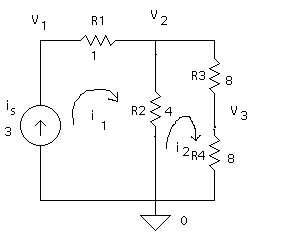i1 R1 + (i1 -i2) R2 - VS1 =0
(R1 + R2) i1 + (- R2) i2 = VS1
(5) i1 + (- 4) i2 = 3
i2 R3 + i2 R4 + (i2 -i1) R2 =0
(- R2) i1 +( R2 + R3 + R4) i2 =0
(- 4) i1 + ( 20 ) i2 =0
| 5 -4 | |i1| | 3 |
| -4 20 | |i2| = | 0 |
| 3 -4 |
det | 0 20 | 60
i1 = -------------------- = -- A
det | 5 -4 | 84
| -4 20 |
i2 = 12 / 84 A

i1 = is
i2 R3 + i2 R4 + (i2 -i1) R2 =0
(- R2) i1 +( R2 + R3 + R4) i2 =0
(- 4) i1 + ( 20 ) i2 =0